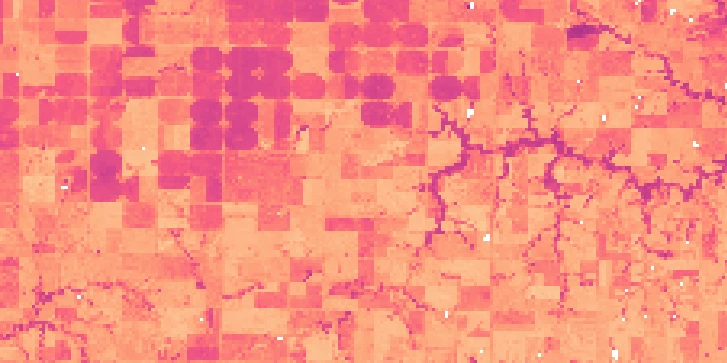Land Surface Temperature

Accurate monitoring of Earth's surface temperature through satellite-derived information supports the understanding of many of our planet’s ecosystems, including physical processes that govern the three major cycles: carbon, energy and water.
Leveraging multiple earth observation datasets and innovative patented technology, Planet provides a twice-daily, global, consistent and accurate Land Surface Temperature products.
These datasets are not just numbers; It is a valuable tool for monitoring changes in cities, or understanding plant health and water availability. Also, this data plays a crucial role in assessing climate and meteorological risks by tracking temperature anomalies and shifts over time using the long archive capability.
What makes the Planet Land Surface Temperature (LST) product stand out is its unique blend of microwave and optical data, allowing the observation of temperature regardless of the cloud condition, so data can be compared consistently over time and space, providing the detailed insights needed for various applications.
Use Cases
Agriculture
- Crop Stress Monitoring - Using LST as input in Energy balanced based Evaporation models, crop stress can be detected early on and allows early intervention.
- Phenology development - LST can be used as input for Growing Degree Days (check out the blog post). Growing degree days (GDD) is a weather-based indicator for assessing crop development. Crop producers use a measure of heat accumulation (temperature) to predict plant and pest development rates as the date for when a crop reaches maturity. The advantage of LST-based GDD lies in its ability to specifically monitor crop conditions, providing insights into the growth and development of crops, as opposed to relying solely on environmental conditions derived from air temperature.
- Seeding Depth Prescription - High resolution LST is promising for understanding within-field variability hence planting depth prescription in order to achieve improved uniformity of emergence and plant stand tailored to local environment, soil and management conditions.
- Yield forecasting model - If used in combination with Soil Water Content and Vegetation Optical Depth, Land Surface temperature can be used in yield forecasting model. Heat anomalies damage yields during different phases of the growing season, making it a critical parameter in the yield prediction model at regional scale.
Weather and Climate Monitoring
Tracking conditions over years and decades, Land Surface Temperature data provides a baseline understanding of normal and abnormal conditions for any given region.
- Heatwave monitoring - Planet LST is able to monitor hot and dry conditions. The relationship between soil moisture and temperature indicates the severity and extent of drought conditions and the effect it has on crops, ecosystems, and the human population.
- Urban Heat Island - Urban environments experience higher temperatures compared to their rural surroundings. Planet Land Surface Temperature can be instrumental in identifying the urban areas most impacted by heat and help governments and local administration to pinpoint interventions.
Environmental Impact Monitoring
- Quantify the effect of restoration initiatives - LST can be used to capture landscape changes due to intervention activities (For example, reforestation) and the impact those changes have on the climate of the region (For example, cooling down).
API Access Information
| API | Available | Notes |
|---|---|---|
| Data API | ❌ | |
| Orders API | ❌ | |
| Subscriptions API | ✅ |
Subscriptions Access
Land Surface Temperature 20 m
Land Surface Temperature 100 m
Land Surface Temperature 1000 m
For more information on the Subscriptions API and code samples, see the API documentation.
Learn More
Planet University
Learn the LST basics with this introduction course.
Blog posts
Read the latest LST news and stories.
Subscriptions API
Get started with the Subscriptions API.
Jupyter Notebooks
Access LST and create visualizations with this tutorial.
EvalScripts
Visualize LST and extract insights with EvalScripts.